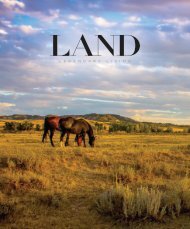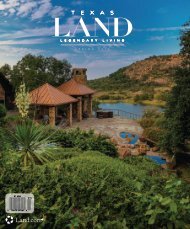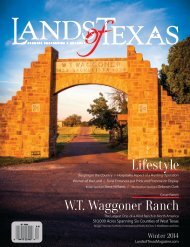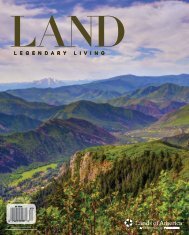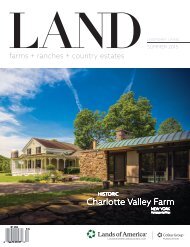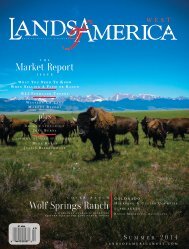You also want an ePaper? Increase the reach of your titles
YUMPU automatically turns print PDFs into web optimized ePapers that Google loves.
TABLE 1 | Minimum Width For Vegetative Filter Strips Where Soil Is Tilled. 1<br />
Slope (%)<br />
Minimum Width in Feet<br />
1–3 25<br />
4–7 35<br />
8–10 50<br />
1<br />
Standards and specifications No. 393, USDA-NRCS field office guide, 2004.<br />
TABLE 2 | Effectiveness Of Filter Strips In Reducing Fecal Coliform Levels Under<br />
Fecal Coliform<br />
Reduction (%)<br />
Slope (%)<br />
Varying Conditions. 2<br />
Buffer Width<br />
In Feet<br />
Runoff Source<br />
43 -74 9 30± Poultry Litter On No-Till Cropland<br />
>99 4 3 -82 Manure On Improved Pastureland<br />
2<br />
Mike Marshall, Texas A&M-Institute of Renewable Natural Resources.<br />
capacity of ponds and lakes.<br />
Water from precipitation also percolates or moves downward<br />
through soil pores to replenish underground aquifers. Pores<br />
in bare ground become sealed and there is essentially no<br />
water percolation; so sparsely covered soil negatively impacts<br />
groundwater supplies.<br />
A covered soil holds more water by binding it to organic<br />
matter and loses less water to runoff and evaporation. The<br />
amount of organic matter increases in soil when it is covered<br />
by vegetation and dead plant material residue. Organic matter<br />
holds 18 to 20 times its weight in water and recycles nutrients for<br />
plants to use. One percent organic matter in the top six inches of<br />
soil holds approximately 27,000 gallons of water per acre.<br />
“Big trees growing along streams can shade the water and<br />
provide good fish and wildlife habitat,” Nelle continues. “Their<br />
massive, far-reaching root systems reinforce the banks against<br />
flood damage and help provide stability. Depending upon the<br />
area, riparian trees can include pecan, elm, cypress, sycamore,<br />
cotton wood, willow or oak.<br />
“Invasive exotic plants such as giant cane, saltcedar, Chinese<br />
tallow and others may sometimes dominate riparian areas. These<br />
plants may form near monocultures and crowd out native plants.<br />
In these cases, selective control measures are warranted.”<br />
PROTECTIVE MANAGEMENT<br />
Selective control measures can involve mechanical removal of<br />
unwanted species leaving the desirable plants undisturbed.<br />
Mechanical methods include various types of saws and<br />
tree grubbers or excavators. A second option is individual<br />
plant treatments (IPT) with herbicides, which includes basal<br />
treatments and stem/leaf sprays. Read and understand the<br />
product label before using any herbicide. Ensure that the<br />
target plants are listed on the label and pay special attention<br />
to any precautions or restrictions on use of the particular<br />
herbicide around water.<br />
“It’s important to avoid overgrazing riparian areas in order<br />
to keep them in healthy condition,” says Marshall. “Animals<br />
may need to be fully excluded from these areas or only given<br />
access for short periods. If the creek, lake or pond is used for<br />
watering livestock, consider other water sources.”<br />
“Grazing is the most important factor that influences<br />
riparian vegetation,” says Nelle. “Heavy and prolonged<br />
grazing damage riparian vegetation and render it ineffective<br />
at retaining sediment. Management in riparian settings<br />
should strive to provide short livestock grazing periods<br />
followed by long rest periods to maintain or enhance desired<br />
plant communities. Only two to four weeks of grazing each<br />
year with a large number of animals may be appropriate<br />
for maintaining good riparian vegetation. This type of flash<br />
grazing can take advantage of large volumes of high quality<br />
forage while still retaining good riparian vegetation. Separate<br />
riparian pastures combined with an observant and diligent<br />
manager will permit this kind of specialized grazing.”<br />
Fencing livestock out of lakes, creeks and rivers reduces<br />
water contamination from soil, manure and urine. Total or<br />
partial exclusion of livestock also helps maintain dense<br />
vegetation to catch and stabilize sediments. For animal<br />
access to water, areas can be graveled where banks are less<br />
likely to erode. These watering areas should be fenced to<br />
prohibit livestock from moving further into the stream.<br />
“Grazing animals with unrestricted access to riparian areas<br />
may remove streamside vegetation, compact or disturb soils,<br />
and break down banks, resulting in both channel incision and<br />
widening of stream beds. Additionally, when grazing animals<br />
have free access to riparian areas, their manure is deposited<br />
or washed into streams. This results in excessive nutrients,<br />
organic matter and pathogenic organisms,” says Machtinger.<br />
“If grazing is managed, livestock manure and urine are<br />
deposited in thick vegetation where it is lodged in place,<br />
quickly decomposed and used by plants,” says Nelle.<br />
“Very little manure and urine get into the water when the<br />
riparian area is heavily vegetated.”<br />
In addition to over-grazing, humans degrade riparian<br />
zones by heavily manicuring and mowing, grading or<br />
paving stream and river banks. Constant use of all-terrain<br />
vehicles (ATVs) and other equipment in riparian areas<br />
and deposition of trash and other foreign material into<br />
rivers and streams are also detrimental to these systems.<br />
Dysfunctional riparian zone characteristics include exposed<br />
soil or gravel on banks and in the floodplain, a wide channel with<br />
shallow water, increased flood flows and excessive erosion often<br />
resulting in stream bank collapse. Other signs of a degraded<br />
riparian system are lack of shade or over-hanging vegetation and<br />
absence of large wood or downed trees in the stream bed. This<br />
results in the loss of fish and wildlife habitat and the dominance<br />
of non-native invasive plants and/or upland species.<br />
In most cases, recommendations by NRCS and other<br />
land management agencies on repairing dysfunctional<br />
riparian zones are to cease or alter damaging practices<br />
and then let nature take its course. Nelle states that<br />
some heavily disturbed riparian plant communities,<br />
especially where the water table has been lowered or<br />
flows interrupted, may not recover in our lifetime. But<br />
most are extremely resilient and can recover as long as<br />
they have time, rest, and adequate water.<br />
LANDMAGAZINES.COM 65




